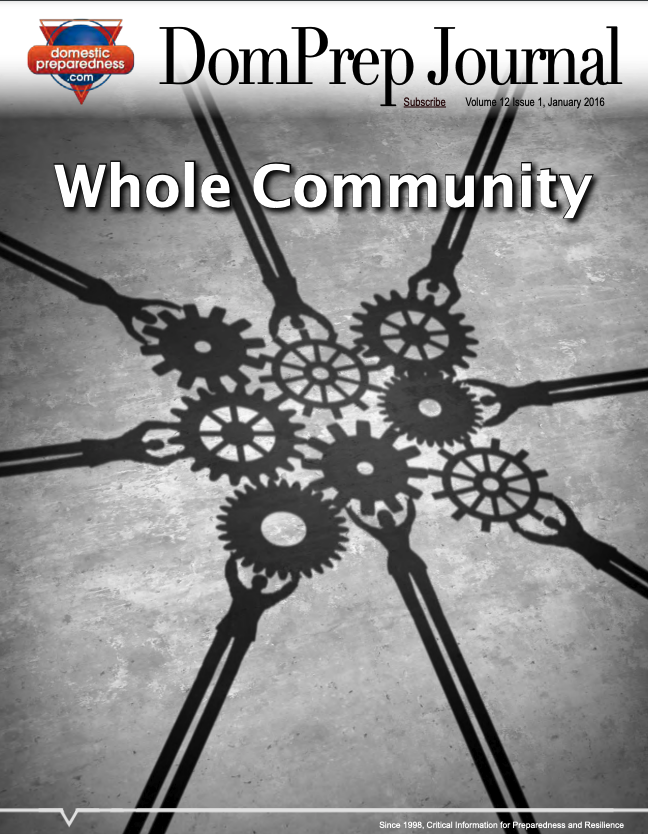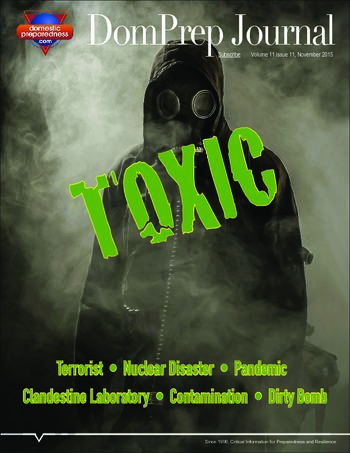
Author Archive

The Center for Disease Control and Prevention (CDC) Office of Public Health Preparedness and Response (OPHPR) leads the agency’s preparedness and response activities by providing strategic direction, support, and coordination for activities. This report highlights how OPHPR strengthens the nation’s health security to save lives and protect against public health

Whole Community
Domestic Preparedness
January 30, 2016
Whole Community A Five-Year Look Back, By Catherine Feinman; What the Whole Community Means to the Whole Community, By Richard Serino & Jennifer Grimes; Four Steps to Improve Whole Community, By Vincent B. Davis; Development of Metrics for Personal Preparedness, By National Emergency Management Executive Academy Cohort III; Ignoring

Medical Countermeasures for Children in Public Health Emergencies, Disasters, or Terrorism
Domestic Preparedness
January 7, 2016
Children represent a particularly vulnerable population during a pandemic, natural disaster, or act of terrorism. Significant and effective collaboration between the pediatric health community and federal partners, over the past five years, has resulted in substantial gains in addressing the needs of children related to disaster preparedness and medical countermeasures.

What’s Next?
Domestic Preparedness
December 30, 2015
See Something . . . Do Something, By Martin D. Masiuk; Climate Change Presents an Emerging, Dynamic Set of Hazards,By Jeffrey N. Rubin; Bioterrorism in a Technologically Advanced World, By Christina M. Flowers; Preparing for the Unknown, By Jerome H. Kahan; Forging New Partnerships for Healthcare Preparedness, By Jessica Wambach

Improving DoD Support to FEMA’s All-Hazards Plans
Domestic Preparedness
December 19, 2015
This research reviews and analyzes how DoD and FEMA work together to plan and execute disaster response activities, and recommends areas for improvement. The objective of the study was to identify ways that DoD can better support FEMA. http://www.rand.org/content/dam/rand/pubs/research_reports/RR1300/RR1301/RAND_RR1301.pdf

WHO Estimates Global Burden of Foodborne Diseases
Domestic Preparedness
December 9, 2015
The World Health Organization’s (WHO) estimates of the global burden of foodborne diseases form the most comprehensive report to date on the impact of contaminated food on health and well-being. It is apparent that the global burden of foodborne diseases is considerable, and affects people of all ages, particularly children

Responders Can Teach CDP Training Through the Indirect Training Program
Domestic Preparedness
December 5, 2015
Emergency responders who attend the Center for Domestic Preparedness (CDP) training can easily become qualified to share that training with their colleagues back home through the CDP’s Indirect Training Program. Several CDP courses offer a “”train-the-trainer”” option by taking an additional day of training at the CDP’s Anniston, Alabama, campus.

Practical Guide for Medical Management of Chemical Warfare Casualties
Domestic Preparedness
December 2, 2015
This guide contains information, guidelines, diagrams, and other materials addressed to medical practitioners who are engaged in the treatment of casualties of chemical weapons.VIEW FULL REPORT

TOXIC
Domestic Preparedness
November 25, 2015
Featured in this issue: Beyond Paris – A Growing Terrorist Threat, By Richard Schoeberl; Public Healths Role Beyond Biologicals, By Audrey Mazurek & Raphael M. Barishansky; Next-Generation, Layered Security Screening, By David W. Cullin; Keeping It Simple – Low-Cost Technologies With High Payoffs, By Timothy Moshier; New Decontamination Resource –

HHS Could Take Further Steps to Enhance Understanding of Public Health Risks
Domestic Preparedness
November 11, 2015
This U.S. Department of Health and Human Services’ (HHS) report addresses: (a) federal activities to enhance understanding about the risks climate change poses to public health; (b) federal resources used by selected states and localities to address these risks; and (c) challenges states and localities face and actions federal agencies
Follow Us
Get Instant Access
Subscribe today to Domestic Preparedness and get real-world insights for safer communities.
ARchives
Follow Us
Get Instant Access
Subscribe today to Domestic Preparedness and get real-world insights for safer communities.


